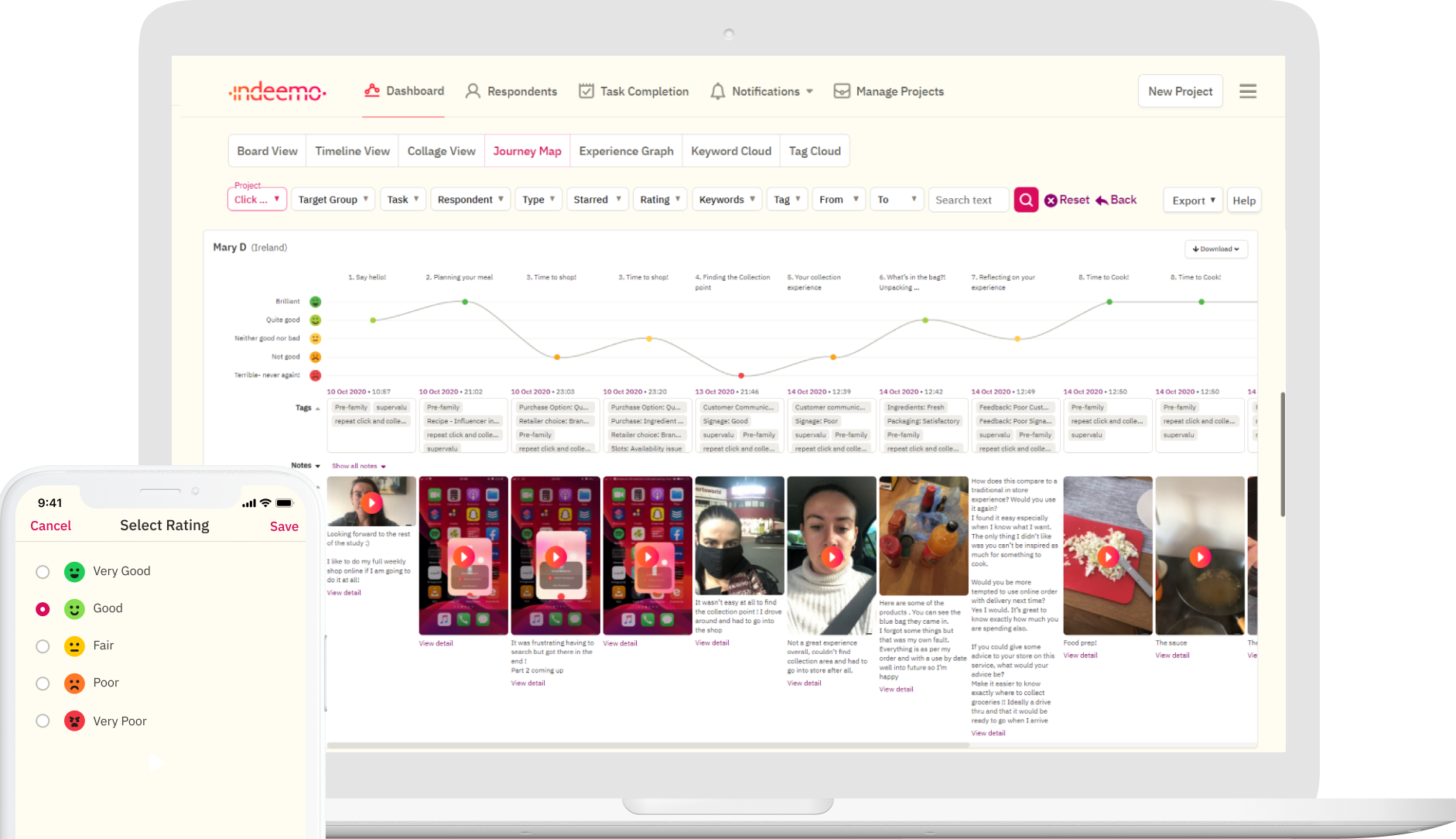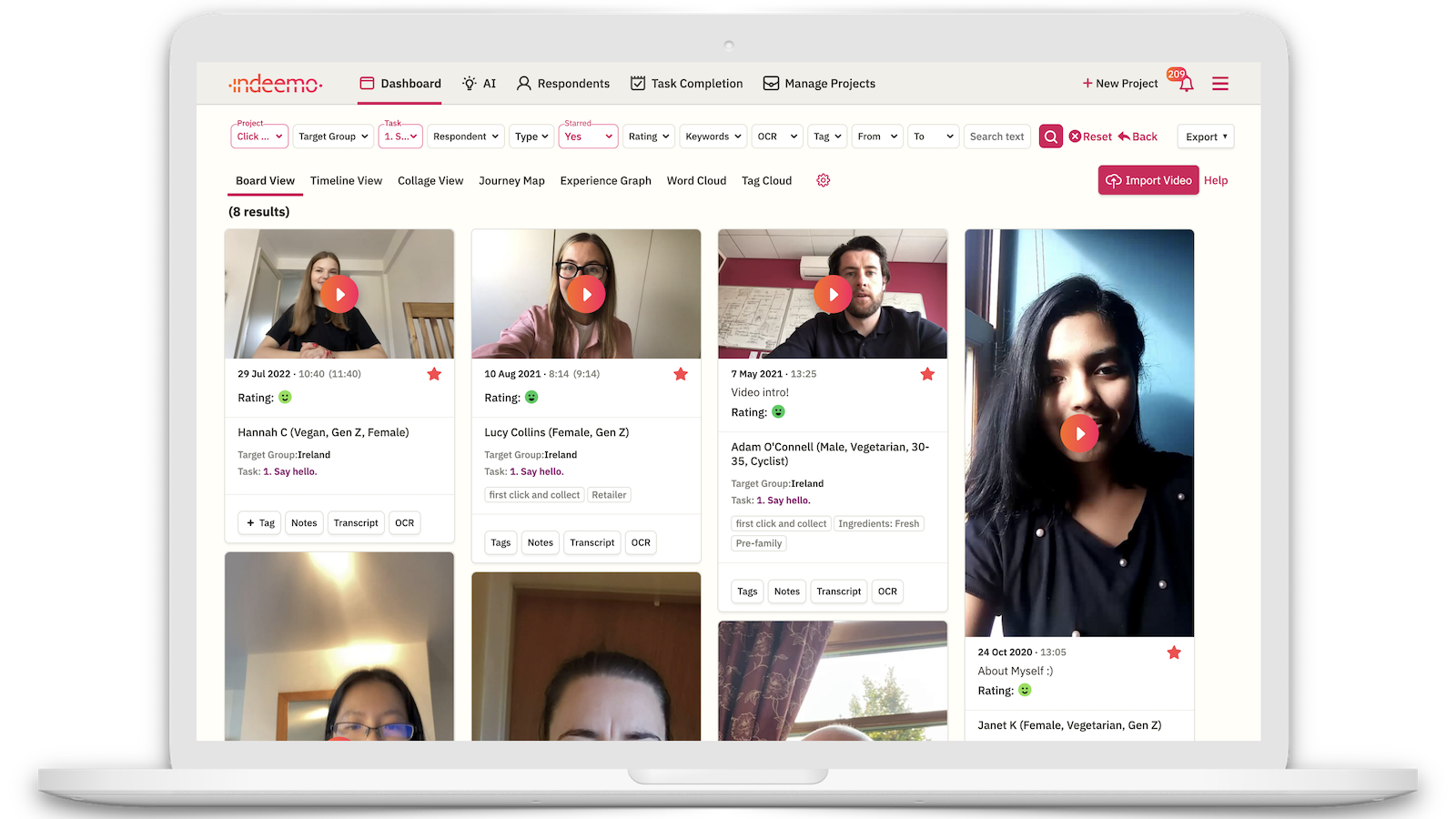It has become difficult to follow your customer through each touchpoint of their journey, especially using traditional quantitative research methodologies only. To deliver a seamless customer experience, you must understand the context of every touchpoint and the “why” of every positive and negative interaction. Our goal at Indeemo is to get you closer to the moments that matter so you can empathise with your customers and deliver a more delightful customer experience.
What is Customer Journey Mapping?
Customer Journey Mapping is all about developing empathy for your customer. It is the process of capturing each and every touchpoint a customer experiences with a brand, product or service. The output of the Customer Journey mapping process typically results in a visual representation of the customer journey, i.e. a customer journey map.
One of the main aims of customer journey mapping research is to develop a deep understanding of the emotions customers experience throughout their journey. Second, the journey map allows you and your entire organisation to understand the context of your customer, at each moment they interact with your brand, product or service.
For any customer centric organisation, providing the best customer experience is essential to success. Marketing, CX, and UX teams must constantly provide leadership and product teams with meaningful customer insights. Customer journey mapping is said to be a type of research that can provide the diverse teams of your organisation with a shared understanding of your customer. More so, Customer journey mapping can be viewed as one of the best research methodologies to build empathy and unearth the real motivations of your customer. So,with this in mind, how can you design research for effective and insight-driven customer journey mapping?
How to do Customer Journey Mapping research?
First, it is important to build a diverse team that will have valuable contributions to your research. Often, CX teams, UX teams, and market research teams work in silos. Although each team might have different goals, there is only one customer. A diverse team with valuable perspectives to bring to the table will help you develop an inclusive research strategy and objective. There should be no doubt that a mix of personas will help uncover more valuable insight into the customer journey. To help you design the best customer journey mapping research, here are a number of tips to consider.
Clarify your journey mapping research objective
Valuable customer journey mapping needs to be insights-driven, informed by rich qualitative data. To do this, you will need to identify the objective. What are the primary goals? What experiences do you need to understand? Who are your customers? You may not have answers to all of these questions, and if so, an exploratory research approach to your customer journey mapping project should be taken.
Choose your preferred customer journey mapping research method
Traditionally, quantitative research methods, like surveys, would be used to help capture the customer journey. However, CX research teams can often be limited with this type of data. Although quantitative methods might capture what the customer journey touchpoints are, you limit capturing the true nature of your customer's journey and experiences.
Exploratory research, or generative research, is qualitative by nature. Adopting qualitative techniques such as diary studies, video diaries, digital ethnography, can enhance our understanding of the real world, contextual customer journey significantly.
Journey Mapping research: recruitment and incentives
Recruitment can be difficult. At times, participants can be reluctant to give up their time to engage in qualitative research. If your organisation does not have quick access to potential participants of your customer journey mapping research, specialist qualitative recruitment agencies can always be brought onboard to find participants, manage recruitment and handle incentives. Incentives, be it monetary or otherwise, are essential to achieve strong engagement for your customer journey mapping research. The incentive amount will vary significantly depending on your customer persona. If you’d like to discuss, please contact one of our strategists.
Fieldwork and pilot testing
Building a robust research strategy will enhance the quality and relevance of the insights that will be captured. For example, a number of tasks will be needed for your customers to record the actions they take, each touchpoint they interact with, and the emotions experienced throughout their journey. Ultimately, you should want to create tasks that will capture the most important details of the customer journey. But how will you know if your customer journey mapping research design will be effective at capturing each piece of behaviour, emotion, and touchpoint?
Get your team to take the customer journey (also referred to as a service safari). Test your methodology and tasks by allowing your user researchers and CX teams to capture and document their experiences with your brand, in real-time. Immediately, you will uncover a number of potential issues with the current customer journey mapping research strategy. Even more, you may find that the journey can be different for each and every customer. A trial and tested run through can give you an idea of what possible personas may emerge through an exploratory approach.
Challenges of Customer Journey Mapping
There are a number of challenges to customer journey mapping research that need to be considered. As previously mentioned, nowadays the customer journey is not linear. By concentrating only on the physical journey from home to store, your team can increase the risk of excluding the possibilities in between.
For example, did the customer first search for your product online? Did they review other channels for purchase? Yes, these omnichannels increase the complexity of developing the customer journey map. However, if we identify these complex channels, we can easily capture each possible journey. One way to overcome this limitation is by adopting an exploratory approach to your customer journey mapping research. If you are unsure of the stages / touchpoints, we recommend that you start off with an open ended study where you tell the respondent to record every touchpoint themselves (without any prompting from you) and then use tagging to code their uploads into stages or touchpoints.
Be mindful of the duration of your research and the requirements you set for participants. Some customer journeys can be hours long, others, e.g Automotive path to purchase journeys can last several weeks. The rate of responses to any type of research is relative to the burden placed on participants. For qualitative research, the journey mapping process should be designed in a way that customers do not feel their participation is burdensome on them. This is another reason why it is important to test your research protocol with your team. Sometimes less is more; there is always risk that the more you ask of participants, the less you get back.
Missing behaviours and experiences are often reported as one of the challenges of customer journey mapping. However, this can be a result of the chosen methodology. Questionnaires will provide a vast amount of quantitative data, but this is often at the expense of insights that can be generated from a qualitative approach.
Empowering customers to document their experiences across the journey as it happens is incredibly valuable. This should be done by implementing qualitative research techniques, such as video diaries, and mobile screen recordings to show each touchpoint across various omnichannels and even buying journeys.
What are the benefits of Customer Journey Mapping?
Building Empathy
One of the key benefits of Customer Journey Mapping research is how it can help insights teams and decision makers build empathy for their customers. Empathising with your customers is essential when it comes to innovation and providing the best customer experience. Customer journey mapping can uncover previously unknown emotions experienced by customers as they interact with your product or service.
More importantly, emotions and motivations can change across the journey. Empathy is often built from the rich insights of qualitative data that is used to develop the journey map. Customers can document their experiences through the use of video diaries, and in doing so you can quickly develop a deep understanding of their journey, as seen through their eyes.
Develop User and Customer Personas
Identify a customer persona. The customer persona can be outlined prior to the journey mapping process, if they have been uncovered from previous built insights. However, through qualitative techniques, and real time data capture, we can uncover unanticipated insights. These insights can often result in a new customer persona being identified.
Uncover key pain points and opportunities
A holistic view of the customer experience can help uncover key issues and gaps through the journey map. Where you can identify pain points across multiple channels, new opportunities are presented that will enable you and your team to innovate and improve the services to provide the best customer experience.
Identify contextual insights
Ultimately, customer journey mapping research should inform the right decisions for product innovation, service design, and quality improvements. Customer journey Mapping is often viewed as one the core processes that helps organisations design and improve the customer experience that is based on valuable insights.
Develop a shared understanding of your Customer Journey
Due to the complexity of the various channels customers can go through, customer journey mapping provides a unified description of the journey a customer makes. This can be leveraged by UX teams, service designers, CX teams, and market researchers. Each team may focus on one particular point of that journey. Nonetheless, the customer journey map is universal to your organisation. It provides a shared understanding of your customer to your organisation.
Reduced research costs
Lastly, it is understood that the information gathered from customer journey mapping helps to reduce costs significantly in an organisation. How? To simply put, the richness of the insights that are generated through customer journey mapping are leveraged for effective decision making. Ultimately, customer services and products are adapting and putting the voice of the customer first. By doing so, the product or service is designed with the customer in mind first. As a ripple effect, organisations start to see increased referrals and sales due to word of mouth.
Customer Journey Mapping Research Tools
In the digital era many brands and organisations can optimise technology for journey mapping. At Indeemo, our agile, Customer Journey Mapping software harnesses the use of video, mobile screen recording, automated video transcription, and real-time qualitative data collection.
Developing a customer journey map happens in real time as each customer persona and participant of a study documents their experiences from beginning to end.
As each participant’s journey map is automatically built on our dashboard, each piece of data is mapped across the touchpoints that have been identified by the research team. This is important because analysis can commence instantly. With the power of in-the-moment, multimedia data capture combined with emotional ratings, CX and insights teams can quickly build empathy.
The Indeemo Customer journey mapping tool can also be used as a central, empathy repository for diverse teams in your organisation. Empathy building occurs as in-the-moment experience data is automatically converted into a context rich journey map documenting the qualitative nature of each touchpoint being captured.
CASE STUDY
Using Mobile Ethnography to help Airlines better understand key Customer Journey moments.
Let us support your next Customer Journey Mapping project
We’ve supported thousands of research projects covering everything from mapping the path to purchase for aquarium filters to mortgage buyer journeys to mapping the patient journey of kidney transplant patients.
If you’d like to discuss a specific customer journey mapping research project or are just curious to learn more, get in touch now.









